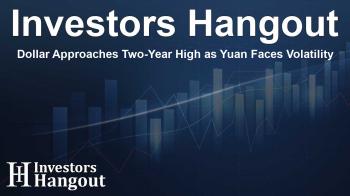Dollar Approaches Two-Year High as Yuan Faces Volatility

The Dollar's Resilience Amid Economic Uncertainty
The dollar remains stable, hovering near its two-year peak as traders anticipate significant economic data releases that may shape the Federal Reserve's monetary policy. The focus this week will largely center on the upcoming nonfarm payrolls report, which is pivotal for understanding the health of the U.S. job market.
Chinese Yuan Under Pressure
Compounding the situation is the recent decline of the yuan, which unexpectedly fell past the critical 7.30 mark against the dollar in the onshore market for the first time in over a year. This development raises questions about the People's Bank of China's (PBOC) commitment to maintaining this key threshold.
The Market's Reaction
Prior to this decline, the PBOC had vigorously defended the 7.30 level, but now analysts observe that their stance has shifted, possibly allowing for a new trading range. Ray Attrill, head of FX strategy at National Australia Bank, suggests that this change necessitates close attention to the PBOC's actions in the coming days, as these could have significant implications for Asian currencies.
Impact on Other Currencies
Interestingly, the Australian and New Zealand dollars—often viewed as proxies for the yuan's performance—moved slightly higher despite the yuan's downward trend. In the early session, the Australian dollar was quoted at $0.6223, while the New Zealand dollar rose to $0.5620.
Anticipation of Fed Policies
In global markets, the spotlight is also on the U.S. employment figures set to release soon, as they could provide crucial insights into the U.S. economy's trajectory. With several Federal Reserve policymakers scheduled to speak this week, investors are eager for commentary on the Fed's stance on interest rates amidst ongoing inflationary pressures.
The Dollar's Climb and Global Position
Driven by expectations of minimal cuts in interest rates this year, the dollar's strength has pushed the euro to its lowest level in over two years. The euro traded lower at around $1.0296, reflecting the market's growing concerns over the European economy's resilience amid U.S. dollar dominance.
Geopolitical Dynamics at Play
The fluctuations in the dollar are not solely driven by economic fundamentals; political uncertainties are also at play. The anticipation surrounding the incoming U.S. President's policies—especially regarding tariffs and potential economic reforms—adds another layer of complexity to currency movements. Investors are keenly aware of the potential impact of these changes on market stability.
Market Sentiment and Future Outlook
Uncertainty prevails, as analysts underscore the unpredictable nature of upcoming policy announcements. The consensus suggests that the strength of the U.S. dollar is likely to continue; it seems highly challenging to advocate against its momentum at this time. Market participants remain cautious but tuned in to any developments that might signal a shift in trends.
Conclusion
As the global economic landscape continues to evolve, the interplay between the dollar and other currencies, particularly the yuan, warrants close monitoring. Traders and investors should be prepared for volatility as market sentiments shift based on economic data and political developments.
Frequently Asked Questions
1. Why is the dollar currently near a two-year high?
The dollar's rise is primarily due to expectations of fewer interest rate cuts from the Federal Reserve amid ongoing inflation concerns.
2. What has happened to the Chinese yuan's value recently?
The yuan recently fell below the critical 7.30 per dollar threshold, indicating increased volatility and challenges for the currency.
3. How do changes in Chinese currency affect other economies?
Fluctuations in the yuan can impact trade balances and economic relationships in countries that rely heavily on Chinese trade, particularly in Asia.
4. What economic data should investors watch this week?
Investors are particularly focused on the upcoming nonfarm payrolls report and comments from Federal Reserve policymakers regarding rates and inflation.
5. How do political events influence currency strength?
Political changes, such as new policies and trade agreements, can significantly impact market sentiment and investor confidence, affecting currency values.
About The Author
Contact Henry Turner privately here. Or send an email with ATTN: Henry Turner as the subject to contact@investorshangout.com.
About Investors Hangout
Investors Hangout is a leading online stock forum for financial discussion and learning, offering a wide range of free tools and resources. It draws in traders of all levels, who exchange market knowledge, investigate trading tactics, and keep an eye on industry developments in real time. Featuring financial articles, stock message boards, quotes, charts, company profiles, and live news updates. Through cooperative learning and a wealth of informational resources, it helps users from novices creating their first portfolios to experts honing their techniques. Join Investors Hangout today: https://investorshangout.com/
The content of this article is based on factual, publicly available information and does not represent legal, financial, or investment advice. Investors Hangout does not offer financial advice, and the author is not a licensed financial advisor. Consult a qualified advisor before making any financial or investment decisions based on this article. This article should not be considered advice to purchase, sell, or hold any securities or other investments. If any of the material provided here is inaccurate, please contact us for corrections.

